
This 1-Ingredient Gluten-Free Buckwheat Bread recipe is an absolute game-changer! I’ve been making it every single week since early 2022, and it never disappoints! It’s incredibly easy, delicious, and super nourishing. I highly recommend throwing a couple of slices in the toaster/oven to create the ultimate avocado toast or as a side dish for dipping into soup. It even makes amazing croutons in a salad!
Since sharing this recipe with our community on social media, it’s become one of our most popular recipes to date. Hundreds of our community members have shared their versions with us on Instagram. Check out our Buckwheat Bread Instagram Highlights to see just a sample of the ones we’ve received, and please make sure to share your own! If you’re in interested in more gluten-free bread recipes, you’ll also love this super fluffy Red Lentil Quinoa Bread!

Ingredient Notes
- Hulled Raw Buckwheat: Buckwheat groats (or kernels) are the hulled seeds of the buckwheat plant. Despite their name containing the word “wheat,” buckwheat is actually gluten-free and makes for a fantastic bread ingredient. These groats are a staple in many Eastern European and Asian cuisines, known for their nutty flavor and versatile use. This Healthy Buckwheat Bread Recipe is a testament to that.
- Water: Tap water is fine to use depending on your location, if the water is heavily chlorinated in your area, you should choose filtered water, as chlorine will impact the fermentation.
- Salt: Either sea salt flakes or table salt works fine. The salt enhances the natural flavor of the buckwheat.
- Poppy and Sesame Seeds: Adds a delightful crunch and visual appeal to the bread. They are optional but highly recommended for an extra touch of flavor and texture. You can top it with any seeds you like.
IMPORTANT: Use ONLY hulled, non-roasted buckwheat for this recipe. Buckwheat flour, unhulled buckwheat, activated buckwheat, or roasted buckwheat will not work in this recipe.
Why You’ll Love This 1-Ingredient Buckwheat Bread Recipe
- Delicious and Dense: It’s absolutely delicious, with a dense, satisfying texture, and gets even better when toasted! Fermentation not only enhances the flavor, but it can improve the bioavailability of certain nutrients in foods. Specifically, the fermentation process can reduce levels of phytic acid, which is known to bind some minerals and reduce their absorption. By breaking down phytic acid, fermentation can make minerals like iron, zinc, and magnesium more available for absorption by the body.
- So Easy: Although the fermentation process takes a bit of time, this recipe is very hands-off and only requires about 10 minutes of actual work. If you use the right kind of buckwheat, a high-speed blender, and follow the instructions, this simple, yeast-free bread recipe is practically foolproof.
- Cost-effective: Good quality, nourishing, gluten-free bread can be quite expensive where we live, often costing around $15 AUD (~ $9.80 USD), whereas this Gluten-Free Buckwheat Bread comes in at under $3.50 AUD (~ $2.30 USD), even when using organic hulled buckwheat.
- Meal-Prep: Easy to prep in advance and can be frozen. I usually keep half fresh, wrapped in a clean kitchen cloth, to consume in the next few days and slice and freeze the rest. Toast when ready to eat, and it’s as good as fresh! This way, you can toast a piece whenever you crave some delicious bread.
What Are the Health Benefits of Buckwheat?
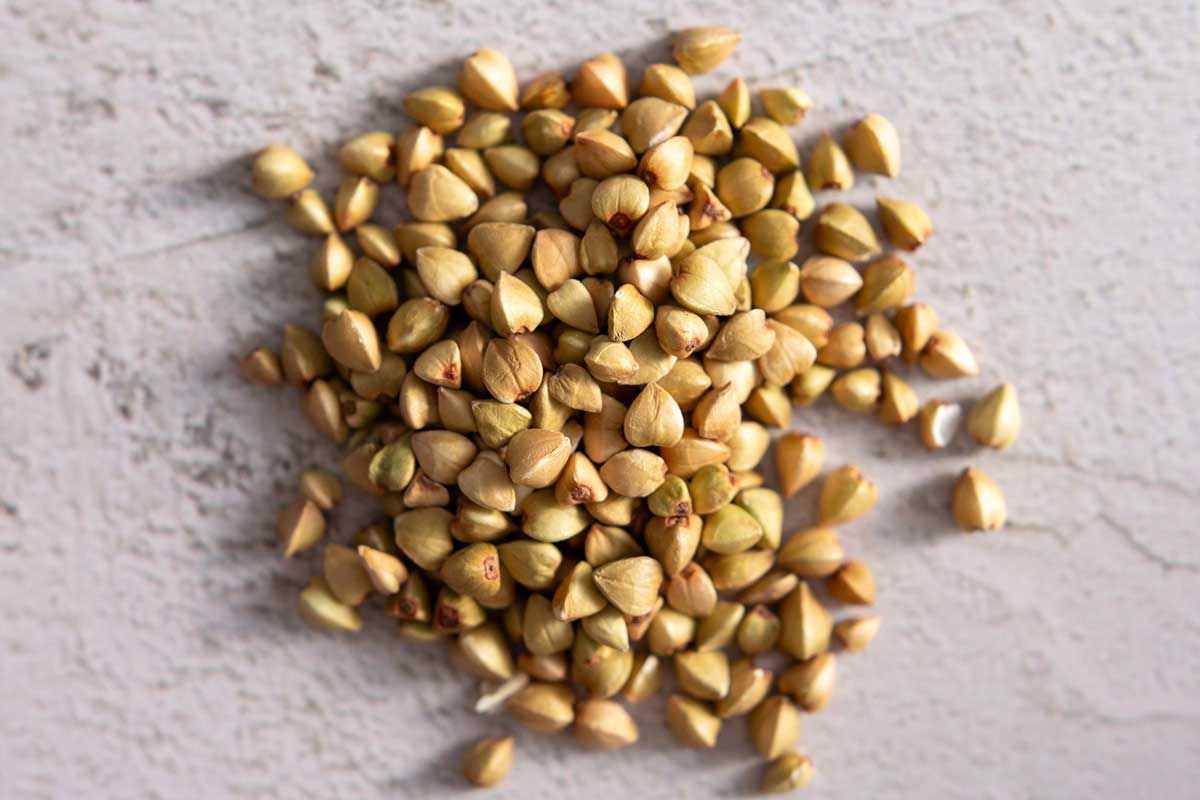
- Buckwheat is highly nutritious, offering a source of fiber and essential minerals, especially magnesium. It’s also packed with antioxidants, particularly rutin, which supports blood vessel health. Despite its name, buckwheat is naturally gluten-free, making it suitable for those with gluten intolerance or celiac disease.
- Buckwheat’s low to medium glycemic index makes it a good choice for those managing blood sugar levels. Plus, its high fiber content aids in digestion.
- Like amaranth or quinoa, these whole grain groats can be cooked like rice or oats, making them a fantastic ingredient for various dishes. From traditional porridge and pilafs to modern salads and even as a rice substitute, buckwheat is incredibly adaptable. It’s also used in making buckwheat flour, a popular alternative for gluten-free baking. We use buckwheat flour to make these High-Protein Buckwheat Pancakes with Blueberry Syrup, and they’re so fluffy and delicious!
Step-by-Step Instructions
Rinse the hulled buckwheat kernels under cold water until clear. After rinsing, soak 17.5 oz (2.6 cups or 500g) of buckwheat in cold water in a large bowl, fully submerged, and cover with a clean cloth for 6 to 7 hours.
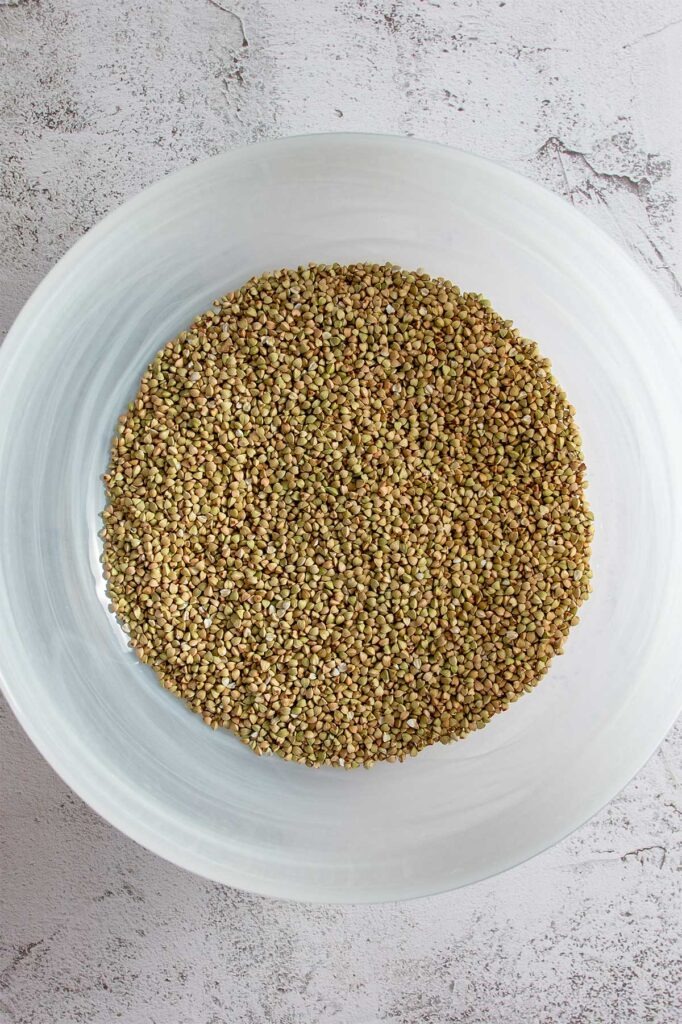

Once soaked, drain the remaining water, but do not rinse.


Transfer to a blender with 6.8 fl oz (0.9 cups or 200 ml) of water and ¼ tsp salt. Blend, starting at low speed and slowly increasing, until you get a very smooth texture without any pieces left. Pour the blended buckwheat mixture back into the bowl.
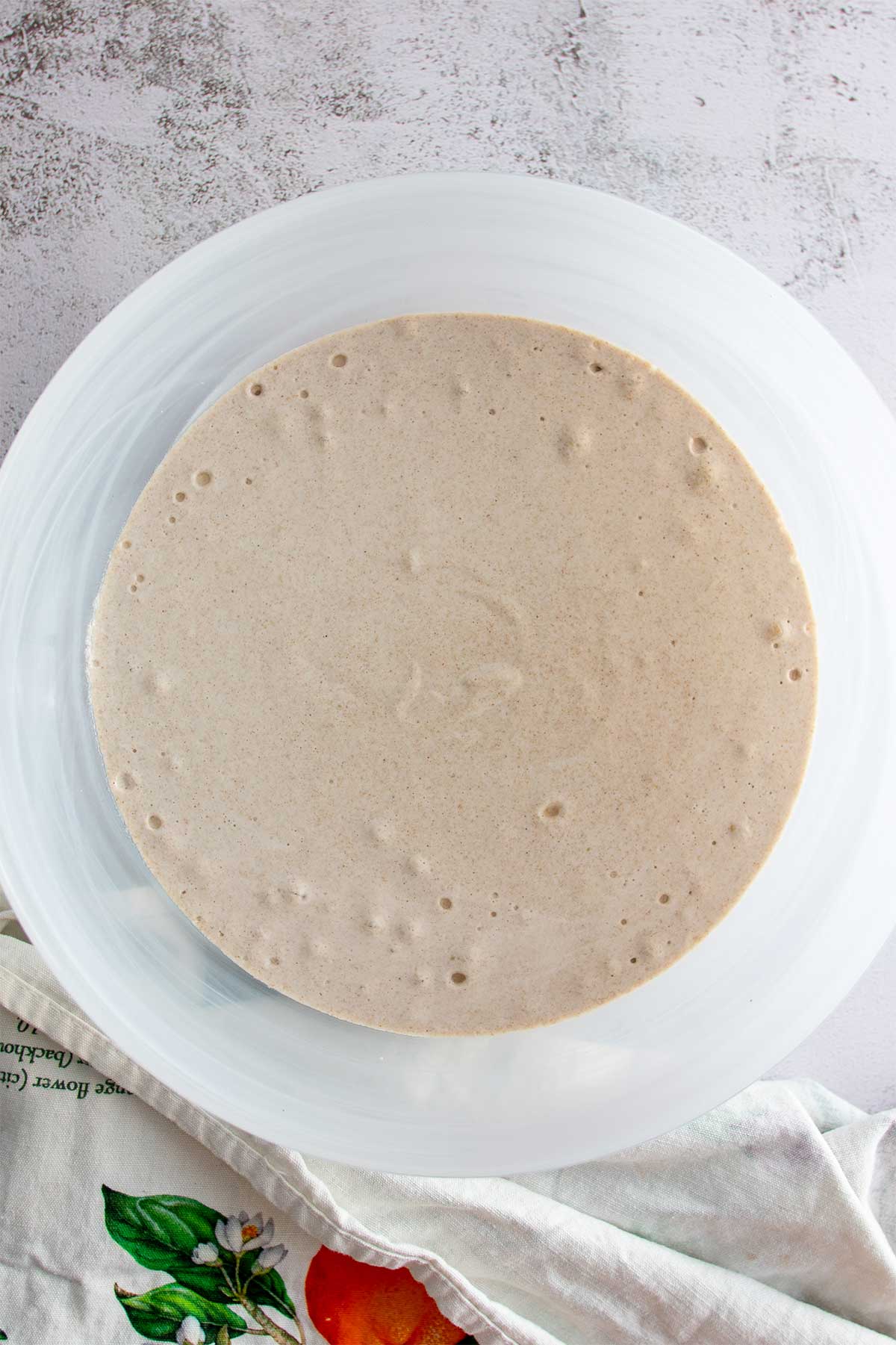
Cover it again and let it sit at room temperature for 12 to 24 hours to ferment. Please check the fermentation table below to confirm the time required based on your current climate.
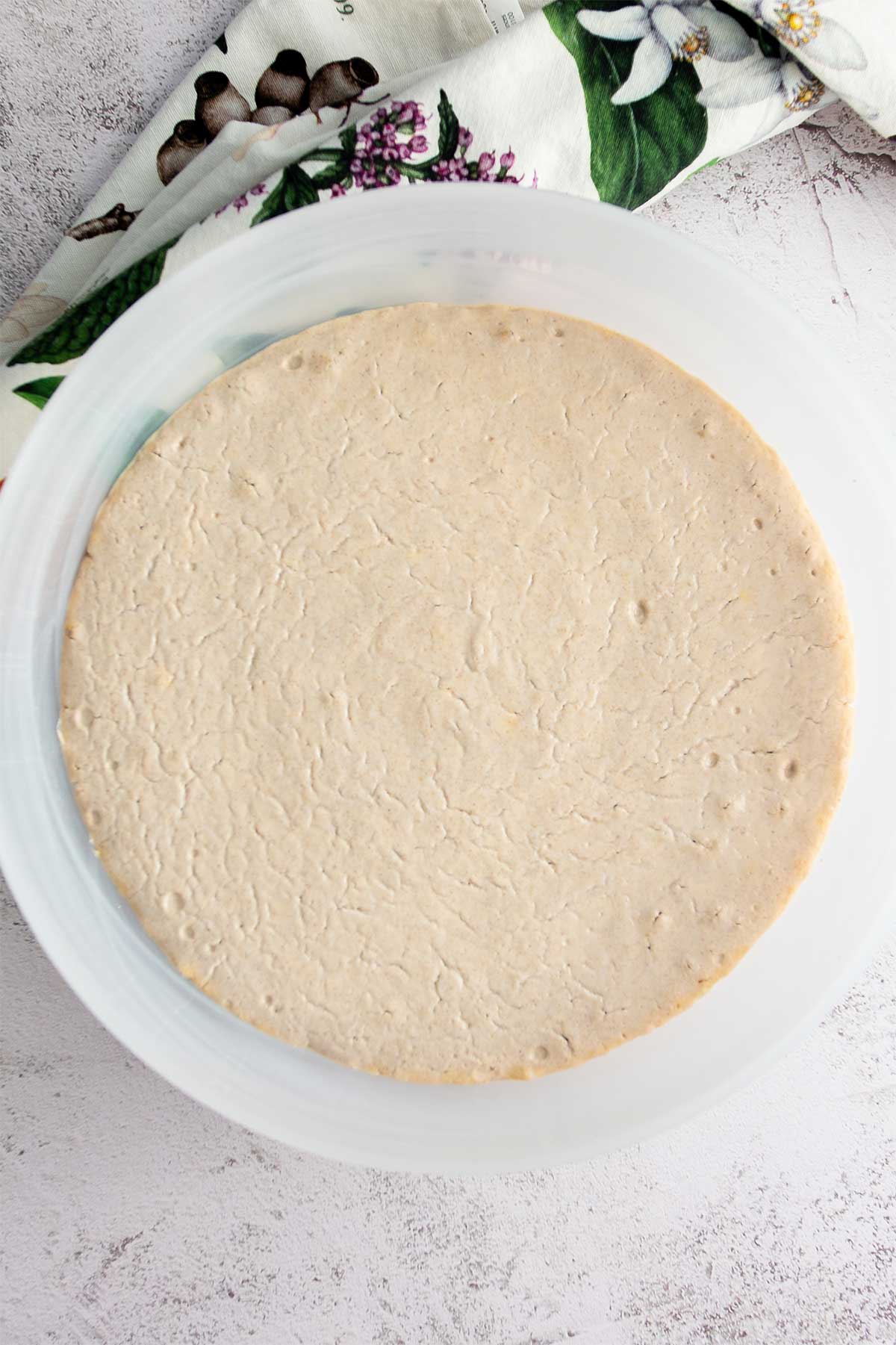

When you’re ready to bake, preheat your oven to 350°F. Line a loaf pan with baking paper and pour the fermented buckwheat dough into the pan. If you’d like, sprinkle the top with 2 tsp of poppy and sesame seeds (or whichever toppings you’d like).


Bake the bread in the preheated oven for 90 minutes. The bread should be golden brown and firm to the touch.


Allow the bread to cool down before slicing. This makes it easier to cut and improves the texture. Enjoy your homemade, nourishing, gluten-free buckwheat bread!


How Long to Ferment Your Buckwheat Bread Based on Your Current Climate
🌨️ Colder (Winter)
Indoor temperature range: ~70°F (20°C)
Soak: 6–7 hours
Fermentation time: Up to 24 hours
Note: If the temperature is lower than 70°F (20°C), place the bread in a warm spot or near a gentle heat source to help it ferment.
☀️ Warm (Summer)
Indoor temperature range: 75–85°F (25–30°C)
Soak: 6–7 hours
Fermentation time: Around 12 hours
Note: A warm environment speeds up fermentation, so check the texture after 10–12 hours.
🔥 Very Hot
Indoor temperature range: Above 85°F (30°C)
Soak: 6 hours
Fermentation time: As little as 6 hours
Note: The hotter it is, the less time needed. In extreme heat, soak the buckwheat in the fridge for 6 hours only.

1-Ingredient Buckwheat Bread (Nourishing and GF)
Equipment
Ingredients
- 17.6 oz (500 g) hulled buckwheat kernels (2.6 cups) - MUST be hulled, raw buckwheat kernels/groats for this recipe to work
- 6.8 fl oz (200 ml) water (0.9 cups)
- ¼ tsp (1.5 g) sea salt flakes
- 2 tsp (4 g) poppy and sesame seeds - optional
Instructions
- Rinse the hulled raw buckwheat kernels under cold water until the water runs clear. This ensures that any dust or impurities are removed.
- Transfer the rinsed buckwheat to a large bowl. Cover the kernels with a large volume of cold water, ensuring they are fully submerged. Cover the bowl with a clean cloth and let it sit for 6 to 7 hours.
- Once soaked, drain the water, but do not rinse the buckwheat kernels. Transfer them to a blender with 6.8 fl oz (0.9 cups/200 ml) water and the salt. Blend, starting at low speed and slowly increasing until you get a very smooth texture without any bits and pieces of buckwheat remaining.
- Pour the blended buckwheat batter back into the bowl. Cover it again and let it sit at room temperature for 12 to 24 hours (please see notes to determine how long you should leave it to ferment based on your climate). Once fermented, you will notice a very slight rise, and the mixture should be slightly bubbly inside.
- When you're ready to bake, preheat your oven to 350 °F. While the oven is heating, prepare a loaf pan by lining it with baking paper.
- Pour the fermented buckwheat dough into the prepared loaf pan. If using, sprinkle the top with poppy and sesame seeds.
- Bake the bread in the preheated oven for 90 minutes.
- Remove the bread from the loaf pan and let it cool completely before slicing. This is important to get the best texture. Now, enjoy your homemade, healthy buckwheat bread!
Video
FAQ
This depends on your location and current temperature, as fermentation is temperature-dependent. Colder climates will need a longer fermentation, and it can be shortened as the temperatures rise during the year, as the heat accelerates fermentation.
For colder climates (winter, with an indoor temperature of approximately 70°F (20°C)), ferment for 24 hours. If your indoor temperature is below 70°F (20°C), you can try leaving the batter in the warmest place in your house to give it the best chance of fermenting.
For warmer climates (summer with an indoor temperature between 75 – 85°F (25 – 30°C), I’d recommend starting with 12 hours of fermentation. We have tested this recipe in both summer and winter in Sydney Australia, which remains a pretty temperate climate. Depending on where you are in the world there might be a little bit of experimenting to figure out the perfect timing, but I promise it’s well worth it!
Some people from our IG community in more exotic locations with hotter and more humid climates have reported good results with as little as 6 hours of fermentation. If this is the case for you, start with 6 hours of fermentation and monitor the dough to avoid over-fermenting. The dough will have a slightly raised appearance and be a little bubbly inside when ready to eat.
Yes, fermentation does have a specific smell, which will be reduced when baking. Over soaking the buckwhat will result in a unpleasant smell, so keep it to 6-7 hours soaking time on the kitchen counter or in the fridge for extremely hot and humid climate.
Yes, it’s completely gluten-free.
This recipe only works with HULLED, NON-ROASTED buckwheat groats.
Unfortunately, it won’t work for this recipe.
It stays fresh for up to 3 days in a sealed container or wrapped in a kitchen cloth. I like to slice half straight away and freeze it to make the most of it.
Yes, slice and freeze for up to a month.
While the base recipe only requires one ingredient and cannot be swapped, you can certainly add other ingredients to customize the bread to your liking. Consider adding seeds, nuts, dried fruits such as dates, or spices for additional flavor and texture. I love a mix of black olives (pitted!), rosemary, and walnuts! Just remember to add these extras after the fermentation process and before baking. I however recommend tasting the bread without any ad-ons first, to make sure you have the perfect fermentation time, and know what to expect in terms of taste and consistency. Then, feel free to experiment with these additional ingredients to achieve your desired balance of flavor and texture.
You can; it will still work, but I find it provides a much-needed touch to the flavor of the bread.
It has a very slight rise – it’s quite different from yeast fermentation. Don’t worry if it looks like your dough hasn’t risen much – it will still work.
If that’s the case, I would recommend rinsing the buckwheat as it might develop a bit of a smell otherwise. It’s still fine to consume. We recommend not to rinse in our recipe, as when we tested it, we got a slightly nicer texture once baked, but it still worked when rinsed.
They are fine to leave on the counter. However, if it’s too hot or humid where you are, you can place them in the fridge. Leave out of the fridge for the fermentation part.
If you slice it before it cools down, it will just have a mushier texture.
If your indoor temperature is lower than the one we have mentioned, it might need to be fermented longer. Use filtered water if the water in your area contains a lot of chlorine, as this will negatively impact fermentation. Someone in the community also mentioned fermenting the dough directly in the loaf pan as a tip to get it to rise even more.


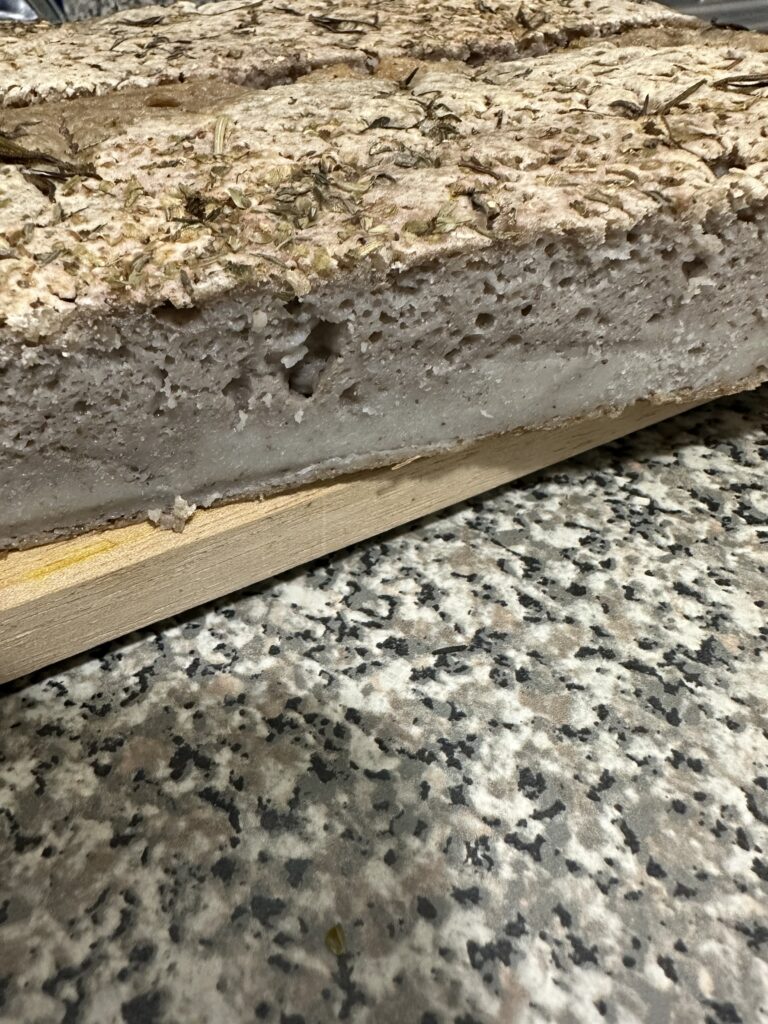
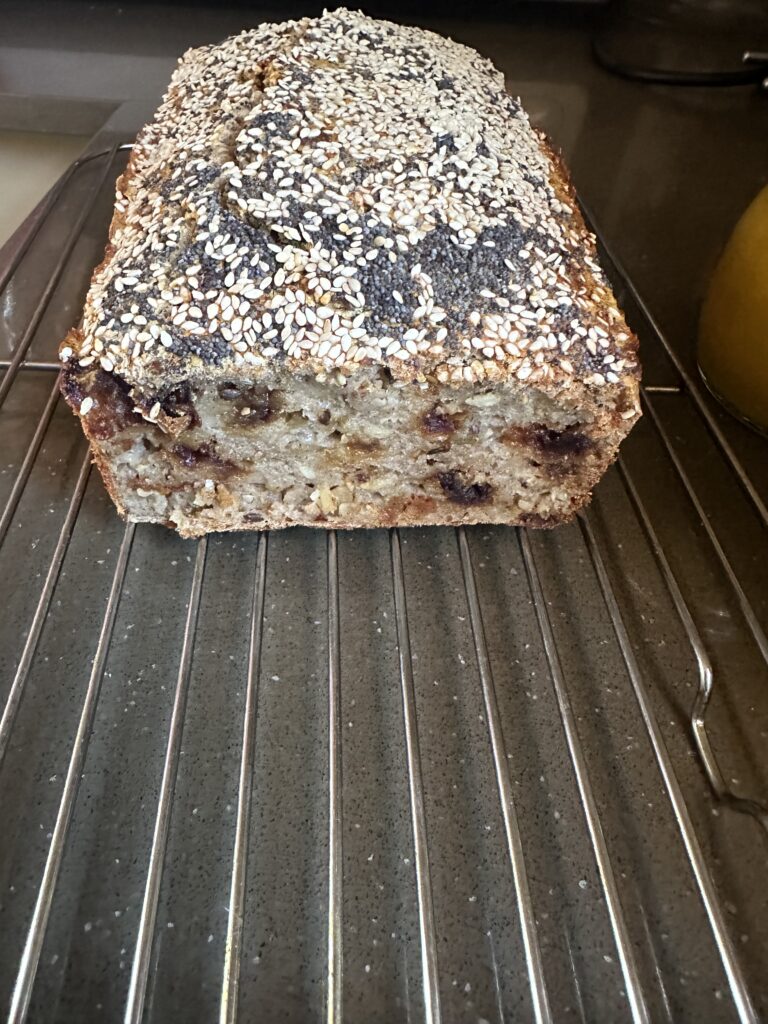








Hi, once fermented can I sprinkle seeds into it as well as on top of it before it put it in the loaf tin? Thanks
Yes 🙂
thanks! Super excited to try this. Just one question… Can we leave it to ferment longer than the recommended time? What will happen then?
A couple of people have reported good results with 30 hours fermentation in colder weather, however I have not tried it myself. Over fermenting might result in an unpleasant smell.
Hope this helps and that you’ll love the bread!
Yes we are in colder weather. Might give that a try. Appreciate the reply 🙂
I’m a little confused on the measurements for the buckwheat and water. Do you have conversions for oz or grams?
You can select metrics, just above the ingredients for the recipe in grams 🙂
Hi, and thank you! I live in Puerto Rico, tropical weather. I follow the instructions 7 hours and 24 hours. My bread has a strong fermented flavor, it’s that normal? Over soaking ? Thanks
It does have a fermented flavour 🙂 For warm tropical weather we recommend soaking for 6 hours and fermenting for 12 hours, hope this helps 💚
Thank you!
Hii all
I am in fermenting part and it smells… I hope it is ok. What I read from the comments it means it is ok. is it ok to bake it before 24 hours of fermenting?
thank you
It has a particular smell but should not be super strong. How long did you soak it for? And, yes you can bake it before 24 hours, especially if it’s warm where you are 🙂
I just took mine out of the oven and let it cool. I sliced it and it looks like it has a purple/red color to the inside. Is this normal?
I have not seen that happen before, maybe the kind of buckwheat you use, did you add any other ingredients or seasonings?
I used Bob’s Red Mill and just added pumpkin and sunflower seeds before baking. Hmmm, still tastes fine though 🙂 Thank you!
Interesting 😅 I’m glad it still tastes good 🙂
Hi. Thanks the receipt. This bread is our favourite. Can I use other seeds? What other seeds do u suggest to make fermented bread and how? Thanks for your help 🙂
For this recipe I only recommend using hulled non roasted buckwheat 🙂 You can use any nuts or seeds you like for the topping. Hope this helps x
Has anyone tried adding any mix-ins? Seeds, oats, dried fruit, nuts? Would love to hear your feedback!
I use to have raisins, sunflowerseed in some. Crushed walnuts and dried apricots in some Hazelnuts an figs in some. And I also have spicies like fennel and cinnamon.
Should it be covered with a towel instead of a plate / lid for the fermenting step?
A towel is great 🙂
Hello,
I tried your recipe to the letter and was delighted with the results! It was a firm, sliceable, deliciously nutty and wholesome bread. I’m wondering if I can add a spoonful of crushed honeycomb to the soaked buckwheat just before grinding it all and letting it ferment. Would fermentation still happen? Many thanks.
I’m so happy to hear that! I’ve never cooked with honeycomb, but would recommend you incorporate it the same way we do nuts, chopped, and stirred in after fermentation, just before baking 🙂 let me know how you go 💚
I tried to message you with this: (if this is a duplicate I apologize,)
LOVE this recipe. Made it twice with exceptional results. Game changer and I’ll likely never eat any other bread.
Question:
Can you add fresh fruit like apples or bananas?
Can you add honey, syrup, brown sugar?
Can you add protein powder?
Thank you
I’m so happy to hear that, thank you for the lovely feedback! I actually have not tried with any of these additions, I think fresh fruits might make it wetter, which I’m not sure would be great. Dried fruits can definitely be added after the fermentation phase, before baking. I think sweeteners would be best added at the blending phase (sugar speeds up fermentation, so you might be able to reduce your fermentation time slightly). And I’m not so sure about the protein powder, but I’m intrigued and will definitely experiment with that! Would love to hear your results if you try any of these 💚
If I don’t have access to Kernels, how can I make this recipe with flour or flakes?
Unfortunately it won’t work for this specific recipe, but I’m working on a buckwheat flour bread recipe I’m hoping to share soon 💚
I want to try this bread very much but am not sure how big a cup is? In the UK we weigh dry ingredients and measure liquids in fluid ounces or litre. If I buy a set of measuring cups are they all a universal size? I wonder Sarah if you are able to translate the cups of buckweat and the waterinto actual weight and measures?
Many thanks Sylvia
Hey lovely, you can select “metrics” just above the ingredient list to get all of our recipes in grams 🙂 in this case its 200ml water and 500g buckwheat. Hope you love the bread, let me know how you go 💚
Hi I live in the UK too. Where would you buy the hulled buckwheat from. And its winter here so would you recommend the 24hr fermentation. I do have my heating on but at night it drops down in temperature. Thank you sara
I’m not sure where you can get it in the UK (I’m in Australia) but hopefully someone else will know 🙂 Definitely the full 24 hours, and let it ferment in the loaf pan. Does it get very cold at night? If so maybe keeping the heater on a bit or waiting until it gets a little warmer will get you the best results. Hope you love the bread 💚
I know sainsburys sell it, and probably holland and barret or grapetree
I just bought some off Amazon.uK.
Organic, hulled , non-roasted.
I’ve bought some in Waitrose
Thank you. I will look
Just put mine into the oven, can’t wait to see the result. But the consistency is not as liquid as yours in the video (I had to scoop it with a spoon) though I took exactly 500g of buckwheat and 200 ml of water. Maybe my blender wasn’t strong enough?
Yes it might be due to the blending part, or it might have fermented a bit more than the one I had on the video 🙂 did you use hulled non roasted buckwheat? Let me know how yu go once it’s cooked 🙂
Yes I used hulled non-roasted buckwheat. It came out smelling deliciously with a wonderful crust. A bit more compact than on your photo. Tastes very buckwheat-y which I guess is what should be expected, tasted good with some butter and cheese!
Hi,
I tried your recipe. After soaking the buckwheat for about 7 hours, I’ve done the fermenting process for about 12 hours. I used a bowl and covered it with a plate. The dough smelled little bit foul today. I’ve baked the bread anyway. Can I eat it oder should I make another try?!
Thank you!
Fermented buckwheat has a specific smell, which will go down once cooked. Over soaking or fermenting, can make the smell stronger. However it should not be smelling foul, how did you go once cooked? Maybe next time you can try soaking it for 6 hours only in the fridge if it’s very hot where you are 🙂
Buckwheat, salt and water makes 3 ingredients. Why does it say 1 ingredient?
Hi, really want to try this recipe. Has anyone made this living in a colder climate? I live in Norway and I’m wondering how long to ferment. It would be inside in my kitchen where the temp is 19degC? Thanks 🙂
Very excited to try this! Accidentally, I left the buckwheat for 24 before I blended it!! I live in Sunny Queensland! Do you think it will still work? Should I perhaps do the second stage for less time? Thanks I’m advance,
We recommend 6 to 7 hours as it can have a bit of a strong smell if oversoaked, but if that’s not the case it’s perfectly fine to use 🙂I would try to ferment for 12 hours on this one. Let me know how you go 🙂
Hi, is it ok to let it soak for more than 7 hours (if I left it over night is that ok?). Thank you
If it’s soaked too long it might developed a smell, but overnight should be fine if it’s not too hot where you are 🙂 how did you go?
Hello, great recipe but after fermentation it smelt very strong is this normal?
Hey Amy, how long did you soak the buckwheat, ferment and what climate are you currently in?